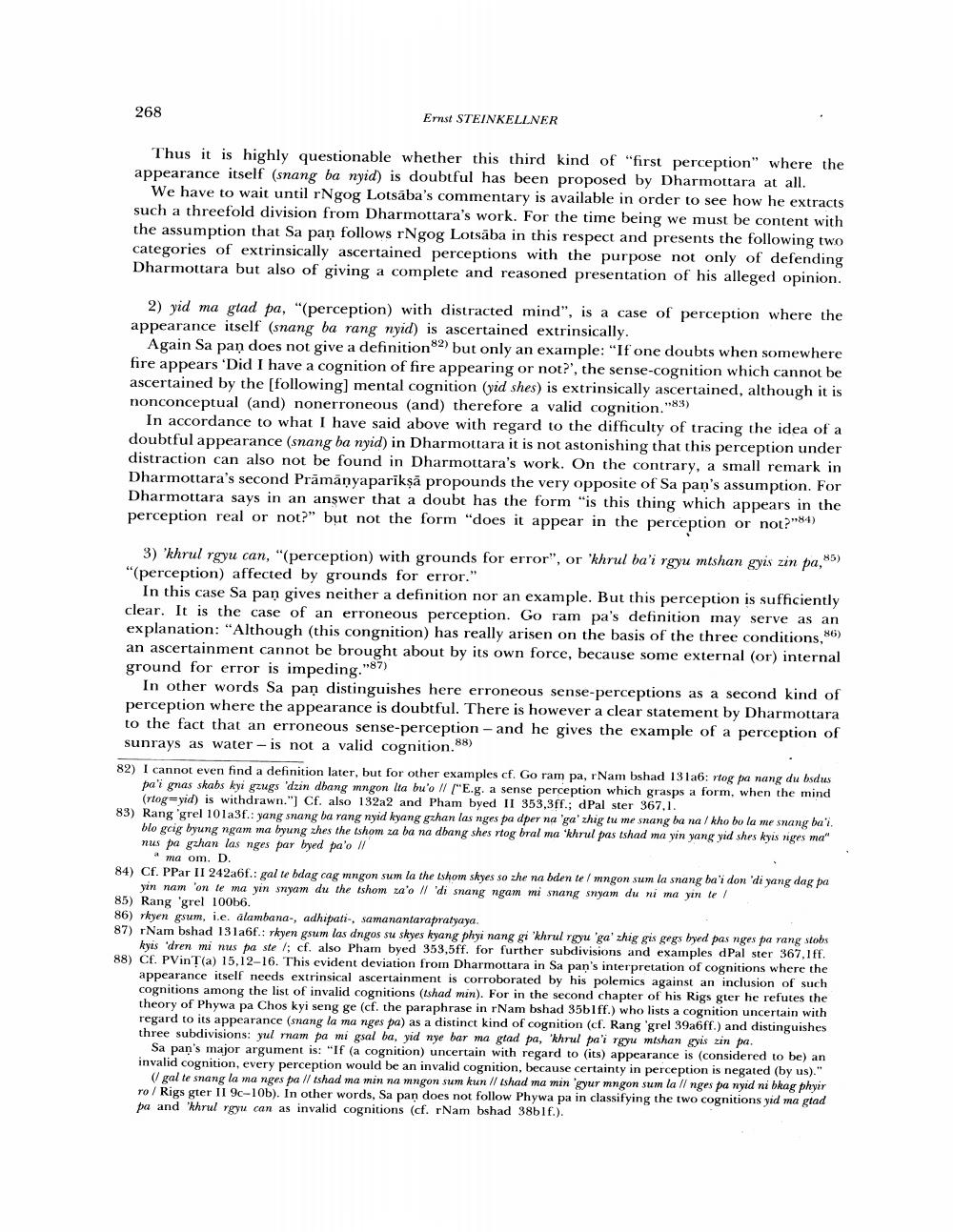________________
268
Ernst STEINKELLNER
Thus it is highly questionable whether this third kind of "first perception" where the appearance itself (snang ba nyid) is doubtful has been proposed by Dharmottara at all.
We have to wait until rNgog Lotsaba's commentary is available in order to see how he extracts such a threefold division from Dharmottara's work. For the time being we must be content with the assumption that Sa pan follows rNgog Lotsaba in this respect and presents the following two categories of extrinsically ascertained perceptions with the purpose not only of defending Dharmottara but also of giving a complete and reasoned presentation of his alleged opinion.
2) yid ma glad pa, "(perception) with distracted mind", is a case of perception where the appearance itself (snang ba rang nyid) is ascertained extrinsically.
Again Sa pan does not give a definition82) but only an example: "If one doubts when somewhere fire appears 'Did I have a cognition of fire appearing or not?', the sense-cognition which cannot be ascertained by the [following] mental cognition (vid shes) is extrinsically ascertained, although it is nonconceptual (and) nonerroneous (and) therefore a valid cognition."83)
In accordance to what I have said above with regard to the difficulty of tracing the idea of a doubtful appearance (snang ba nyid) in Dharmottara it is not astonishing that this perception under distraction can also not be found in Dharmottara's work. On the contrary, a small remark in Dharmottara's second Pramanyaparīkṣā propounds the very opposite of Sa pan's assumption. For Dharmottara says in an answer that a doubt has the form "is this thing which appears in the perception real or not?" but not the form "does it appear in the perception or not?"84)
3) 'khrul rgyu can, "(perception) with grounds for error", or 'khrul ba'i rgyu mtshan gyis zin pa,85) "(perception) affected by grounds for error."
In this case Sa pan gives neither a definition nor an example. But this perception is sufficiently clear. It is the case of an erroneous perception. Go ram pa's definition may serve as an explanation: "Although (this congnition) has really arisen on the basis of the three conditions, 86) an ascertainment cannot be brought about by its own force, because some external (or) internal ground for error is impeding."87)
In other words Sa pan distinguishes here erroneous sense-perceptions as a second kind of perception where the appearance is doubtful. There is however a clear statement by Dharmottara to the fact that an erroneous sense-perception - and he gives the example of a perception of sunrays as water is not a valid cognition.88)
82) I cannot even find a definition later, but for other examples cf. Go ram pa, rNam bshad 131a6: rtog pa nang du bsdus pa'i gnas skabs kyi gzugs 'dzin dbang mngon lta bu'o // ["E.g. a sense perception which grasps a form, when the mind (rtog=yid) is withdrawn."] Cf. also 132a2 and Pham byed II 353,3ff.; dPal ster 367.1.
83) Rang 'grel 101a3f.: yang snang ba rang nyid kyang gzhan las nges pa dper na 'ga' zhig tu me snang ba na / kho bo la me snang ba'i. blo geig byung ngam ma byung zhes the tshom za ba na dbang shes rtog bral ma 'khrul pas tshad ma yin yang yid shes kyis niges ma" nus pa gzhan las nges par byed pa'o II
a ma om. D.
84) Cf. PPar II 242a6f.: gal te bdag cag mngon sum la the tshom skyes so zhe na bden te / mngon sum la snang ba'i don 'di yang dag pa yin nam 'on te ma yin snyam du the tshom za'o // 'di snang ngam mi snang snyam du ni ma yin te 85) Rang 'grel 100b6.
86) rkyen gsum, i.e. alambana-, adhipati-, samanantarapratyaya.
87) rNam bshad 131a6f.: rkyen gsum las dngos su skyes kyang phyi nang gi 'khrul rgyu 'ga' zhig gis gegs byed pas nges pa rang stobs kyis 'dren mi nus pa ste ; cf. also Pham byed 353,5ff. for further subdivisions and examples dPal ster 367,1ff. 88) Cf. PVinȚ(a) 15,12-16. This evident deviation from Dharmottara in Sa pan's interpretation of cognitions where the appearance itself needs extrinsical ascertainment is corroborated by his polemics against an inclusion of such cognitions among the list of invalid cognitions (tshad min). For in the second chapter of his Rigs gter he refutes the theory of Phywa pa Chos kyi seng ge (cf. the paraphrase in rNam bshad 35b1ff.) who lists a cognition uncertain with regard to its appearance (snang la ma nges pa) as a distinct kind of cognition (cf. Rang 'grel 39a6ff.) and distinguishes three subdivisions: yul rnam pa mi gsal ba, yid nye bar ma gtad pa, 'khrul pa'i rgyu mtshan gyis zin pa.
Sa pan's major argument is: "If (a cognition) uncertain with regard to (its) appearance is (considered to be) an invalid cognition, every perception would be an invalid cognition, because certainty in perception is negated (by us)."
gal te snang la ma nges pa II tshad ma min na mngon sum kun // tshad ma min 'gyur mngon sum la // nges pa nyid ni bkag phyir ro/ Rigs gter II 9c-10b). In other words, Sa pan does not follow Phywa pa in classifying the two cognitions yid ma gtad pa and 'khrul rgyu can as invalid cognitions (cf. rNam bshad 38b1f.).




